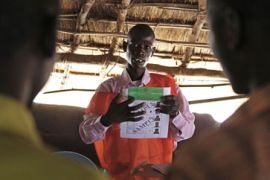The elections in numbers
Around 16 million registered voters, more than 16,000 polling centres and up to 12 ballots.

 |
| The decision by some oppositions parties to boycott Sudan’s first multi-party elections raises concerns over the credibility of the elections [AFP] |
 11 April 2010 sees the start of first multi-party national elections in 24 years
11 April 2010 sees the start of first multi-party national elections in 24 years
 12 presidential candidates representing 10 political parties with two independents contesting the election
12 presidential candidates representing 10 political parties with two independents contesting the election
 11 of the candidates are Muslims
11 of the candidates are Muslims
 1 is a Christian Southerner
1 is a Christian Southerner
 1 is a woman
1 is a woman
 50 is the percentage of total votes needed to win the presidential race
50 is the percentage of total votes needed to win the presidential race
 450 seats available for the national assembly
450 seats available for the national assembly
 2,000 candidates for the national assembly
2,000 candidates for the national assembly
 250 of whom are independent candidates
250 of whom are independent candidates
 72 registered political parties
72 registered political parties
 8 ballots in northern states of Sudan
8 ballots in northern states of Sudan
 12 ballots in southern states of Sudan
12 ballots in southern states of Sudan
 15,700,000 registered voters (81% of all eligible voters)
15,700,000 registered voters (81% of all eligible voters)
 10,335 polling centres in the northern Sudan
10,335 polling centres in the northern Sudan
 5,748 polling centres in southern Sudan
5,748 polling centres in southern Sudan
 16,083 polling centres in total across the country
16,083 polling centres in total across the country
 21,000 polling centres originally planned
21,000 polling centres originally planned
 1,200 voters expected for each polling station in the north
1,200 voters expected for each polling station in the north
 1,000 voters expected for each polling station in the south
1,000 voters expected for each polling station in the south
 7 staff at each polling station in the south
7 staff at each polling station in the south
 250,000 accredited local and international election observers
250,000 accredited local and international election observers
 171 seats available for southern Sudan legislative assembly
171 seats available for southern Sudan legislative assembly
 48 seats available for state assemblies, except Khartoum and Southern Kordofan
48 seats available for state assemblies, except Khartoum and Southern Kordofan
 84 seats available for the Khartoum state assembly
84 seats available for the Khartoum state assembly
 54 seats available for the southern Kordofan state Assembly
54 seats available for the southern Kordofan state Assembly
 15 seats for western Darfur province where most Darfur war victims took refuge
15 seats for western Darfur province where most Darfur war victims took refuge
 24 seats given to northern Darfur, considered a stronghold of the ruling party
24 seats given to northern Darfur, considered a stronghold of the ruling party